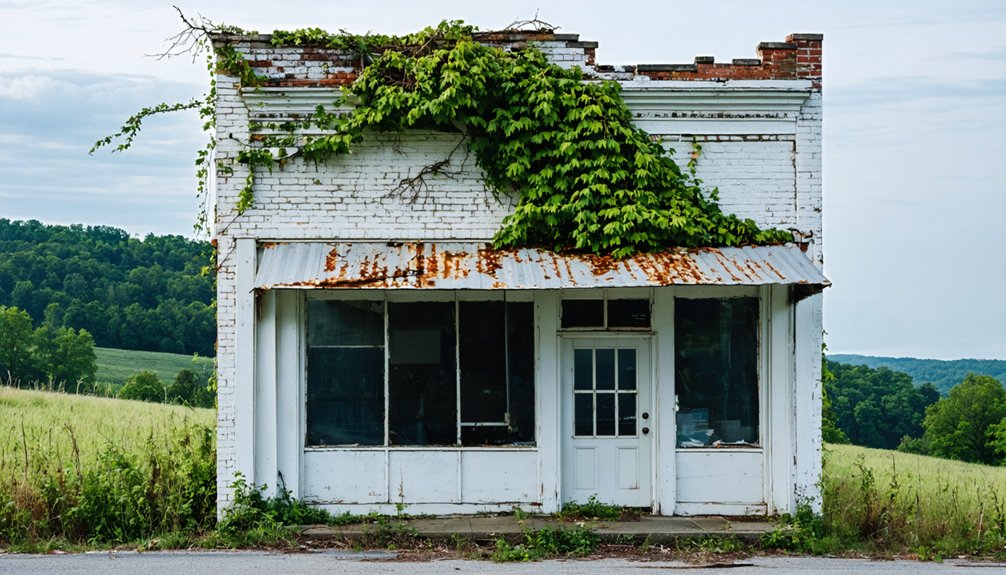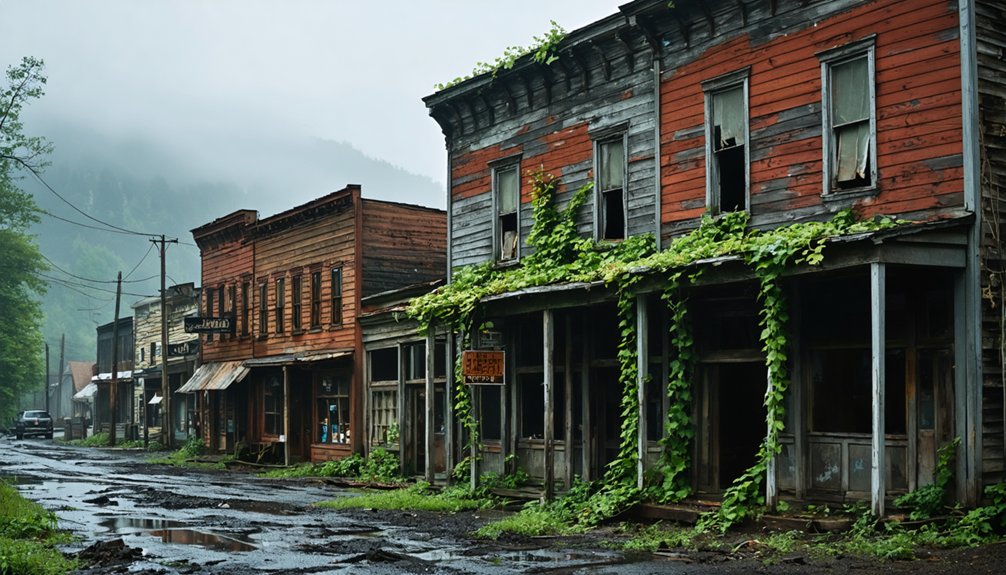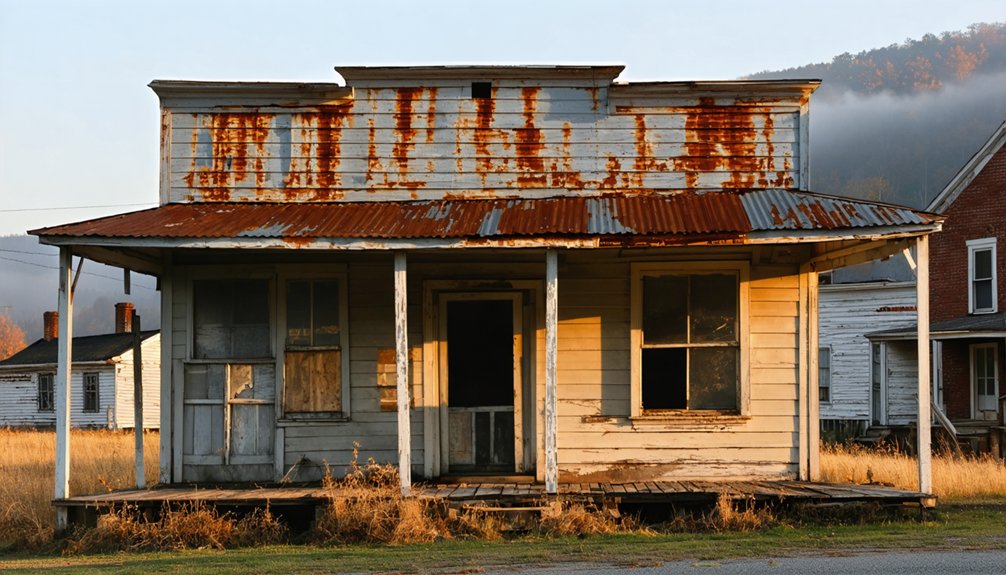You’ll find Pee Vee in Kentucky’s Eastern Coalfield region, where it emerged as a bustling coal town named after the Clutts railroad station. Miners worked grueling 12-hour shifts, earning $10-30 weekly in company scrip while living in basic two to three-room company housing. The town flourished during the 20th century’s coal boom but declined as mechanization and depleted reserves led to widespread job losses. The abandoned landscape holds countless stories of Appalachian mining heritage.
Key Takeaways
- Pee Vee originated as a coal mining town named Clutts, established during Kentucky’s Eastern Coalfield region expansion in the early 20th century.
- The town’s economy relied entirely on coal mining, with residents living in company-owned housing and using scrip for purchases.
- Environmental degradation, coal depletion, and mining mechanization led to widespread job losses and eventual abandonment of the town.
- Most original structures have disappeared, though some architectural remnants of the coal mining era remain scattered across the landscape.
- Former residents relocated due to declining mining opportunities, transforming Pee Vee from a bustling industrial center into a ghost town.
Origins of a Coal Town Legacy
While Kentucky’s coal mining heritage stretches back to Thomas Walker’s 1750 discovery, the establishment of Pee Vee in Harlan County emerged during the broader expansion of coal towns across the Eastern Coalfield region.
You’ll find Pee Vee’s story deeply woven into the industry’s dramatic growth, which saw production soar from just 328 tons in 1820 to over a million tons by 1879.
Named after the Clutts railroad station that shipped its coal, Pee Vee exemplified the community resilience that defined these company towns.
Despite its humble railroad origins, Pee Vee stood as a testament to the enduring spirit of Appalachian coal communities.
Like many of its neighbors, it grew around the mining operations with company-owned housing and a commissary at its heart.
The U.S. Coal and Coke Company, a U.S. Steel subsidiary, played a pivotal role in developing such towns and their essential infrastructure.
Workers received six to seven cents per ton of coal mined in the early years, reflecting the challenging economic conditions of the era.
The area would become one of Kentucky’s most productive regions, with 917.66 million tons of coal extracted from Harlan County alone.
Life in the Mining Community
You’ll find that miners in Pee Vee endured grueling 12-hour shifts underground, earning their wages in company scrip rather than U.S. dollars. Workers could exchange their earnings at the C.E. Flanary Store that served the community from 1904 to 1928.
Your family would’ve lived in a modest company-owned house, typically featuring two to three rooms with basic amenities provided by the mining operation. The advent of strip mining techniques in the region gradually reduced the need for underground miners.
If you’d worked the mines, you’d have spent your days alongside fellow miners who became like family, sharing the dangers and camaraderie that characterized life beneath the earth’s surface.
Daily Work and Wages
Life as a coal miner in Pee Vee demanded grueling physical labor during shifts that stretched from 8 to 12 hours underground.
You’d face constant workplace hazards while cutting coal, loading cars, and maintaining equipment in poorly lit, dust-filled tunnels. Your earnings weren’t guaranteed – you’d get paid by the ton, not by the hour, making wage negotiations nearly impossible.
The company controlled your finances through scrip, which you could only spend at their store. You’d earn between $10 to $30 weekly, but watch those earnings shrink after deductions for rent, tools, and supplies. For historical accuracy, miners were encouraged to revise internal links in company records to reflect their actual hours and production.
Despite the physical toll, inadequate safety measures, and economic restrictions, you’d keep working – there weren’t many other options in Appalachian Kentucky. The mines might’ve offered a livelihood, but they held you in a cycle of dependence. Today, researchers can access these mining records through digital collections to study the historical working conditions.
Family Housing Conditions
Moving into a company-owned house meant accepting cramped quarters with minimal amenities, as most Pee Vee miners and their families squeezed into small wooden frame dwellings that lacked indoor plumbing and electricity.
You’d share outdoor privies with neighbors and rely on kerosene lamps for light. Despite these harsh conditions, community resilience emerged through shared hardships – families looked after each other’s children and gathered for social activities near their homes.
Your housing stability depended entirely on keeping your mining job, as rent came straight from your wages. The coal dust that coated everything inside your home posed constant health risks, while poor insulation and dampness made winters especially challenging. Today, many former residents have relocated due to environmental degradation and declining mining opportunities. Like many families affected by the 2022 floods, residents found themselves facing forced relocation away from their longtime homes.
Yet you’d find strength in your neighbors, forming tight-knit bonds that helped offset the daily struggles of life in company housing.
Social Life Underground
As railroads carved through Harlan County in the early 1900s, Pee Vee’s social fabric emerged from a rich tapestry of ethnic backgrounds and shared experiences.
You’d find yourself part of a tight-knit community where social gatherings weren’t just events – they were lifelines connecting diverse groups of miners and their families.
The underground networks you’d build weren’t just about coal extraction; they were about survival and solidarity.
In the depths of the mines, you’d forge unbreakable bonds with fellow workers from different cultures and backgrounds.
Above ground, these connections flourished through community festivals, music sharing, and storytelling sessions.
The mountainous terrain of Harlan shaped both the mining operations and the close community bonds that developed there.
Despite limited recreational options in this remote company town, you’d discover that the strength of human connections made up for what Pee Vee lacked in modern amenities.
The Rise and Fall of Local Industry
When coal mining took root in the small town of Clutts – later renamed Pee Vee – it transformed the quiet Harlan County settlement into a bustling industrial center.
You’d have witnessed the rapid development of housing, services, and infrastructure built specifically for miners and their families, marking the beginning of a profound industrial legacy.
During the 20th century, Pee Vee’s prosperity soared alongside coal demand, but this success proved fleeting.
Much like how Kentucky’s Noble Butler shaped communities, local leaders tried to establish cultural institutions in Pee Vee.
As mines mechanized and coal reserves depleted, jobs vanished. You would’ve seen the town’s community resilience tested as unemployment rose and families moved away.
Mining companies that once controlled the town’s destiny shuttered operations, leaving behind environmental challenges and economic hardship.
Despite attempts to diversify, Pee Vee’s economy couldn’t recover from the coal industry’s collapse, though its mining heritage remains deeply woven into local identity.
Geography and Natural Surroundings

The rugged terrain of eastern Kentucky’s Appalachian Mountains sets the stage for Pee Vee’s distinct geography. At 1,522 feet above sea level, you’ll find this ghost town nestled among steep slopes and dense hardwood forests, where the topographical features have shaped both natural and human activities.
- Discover diverse ecosystems where oak, hickory, and maple trees provide habitat for white-tailed deer and native birds.
- Experience the area’s complex network of streams feeding into the Cumberland River watershed.
- Explore a climate where you’ll enjoy cooler summers than Kentucky’s lowlands, with occasional winter snowfall.
The region’s ecological diversity remains evident despite historical mining impacts, with natural springs dotting the landscape and native wildlife still thriving in the surrounding forest.
Mountain ridges and valleys create unique microclimates, offering a glimpse into Appalachia’s natural heritage.
Cultural Heritage and Social Fabric
Deep within Harlan County’s coal country, Pee Vee’s cultural heritage reflects the powerful bonds forged by generations of mining families.
You’ll find a story of community resilience in the town’s evolution from its original name, Clutts, marking a shift that echoed through its mining identity.
The social fabric once thrived on shared labor experiences, with tight-knit networks of families supporting each other through the challenges of coal town life.
Community events and labor solidarity shaped daily interactions, creating lasting connections that defined Pee Vee’s character.
Though economic decline and mine closures led to outmigration, cultural nostalgia lives on through preservation efforts.
Local historical societies now work to document these ghost towns, ensuring that the powerful legacy of Kentucky’s coal communities endures despite their physical transformation.
Architectural Remnants and Landmarks

Remnants of Pee Vee’s coal mining past dot the Kentucky landscape, though few original structures remain standing today.
Like many of Kentucky’s abandoned mining towns, architectural preservation efforts have focused on protecting what’s left of these historical landmarks.
You’ll find similar stories of industrial heritage throughout the region:
- The Blue Heron Mining Camp, with its rustic facilities preserved within the Big South Fork National River area
- Pewee Valley’s bright red caboose, maintained by dedicated locals since 1971
- The Kentucky Confederate Home, standing as one of the area’s most significant architectural survivors
These structures tell the story of Kentucky’s industrial evolution, from thriving coal camps to ghost towns.
Today, nature gradually reclaims many of these sites, creating a haunting blend of human history and wild Kentucky landscape.
Economic Transformation Through Time
As you explore Pee Vee’s economic history, you’ll find a town that grew from a thriving coal mining community named Clutts into a ghost town.
The coal industry’s boom provided steady employment and supported local businesses until market changes and industry decline triggered widespread job losses.
You’ll notice how Pee Vee’s inability to diversify beyond coal ultimately led to its abandonment, reflecting a common pattern among Appalachian mining towns.
Coal’s Rise and Fall
When explorer Thomas Walker discovered coal in Kentucky in 1750, he couldn’t have predicted how this resource would transform the region’s economic landscape. Commercial coal mining began modestly in 1820, but by 1879, Kentucky’s production had soared to one million tons, setting the stage for boom towns like Pee Vee.
- Coal camps emerged as company-controlled communities, where miners relied on scrip currency and company stores.
- Labor unions fought against exploitation during the 1920s-30s, making Harlan County a symbol of workers’ struggles.
- World Wars I and II drove unprecedented demand, but post-war shifts to oil and gas sparked decline.
You’ll find Pee Vee’s story mirrors countless Appalachian communities: rapid growth followed by sharp decline as mechanization reduced jobs and mines closed, leaving ghost towns in their wake.
Mining to Modern Economy
Before coal transformed Pee Vee into a bustling company town, the Cumberland Gap region thrived on pioneer-driven commerce, with figures like Daniel Boone and Dr. Thomas Walker establishing essential trade routes in the 1700s.
You’ll find that early settlements depended on rivers and fertile land, with small villages like Oxford (later Pee Vee) developing around taverns, schools, and mills.
As mining technology advanced, you’d see the landscape shift dramatically. Coal operations brought railroads, worker housing, and new infrastructure, but this progress came at a price.
While mining initially strengthened community resilience through steady employment, the industry’s decline led to widespread abandonment. Towns like Paradise and Pee Vee couldn’t survive the perfect storm of resource depletion, mechanization, and changing energy markets, ultimately becoming ghost towns with only cemeteries and scattered buildings as remnants.
Historical Significance in Appalachia

The historical legacy of Pee Vee, Kentucky, exemplifies the broader story of Appalachia’s coal-driven development during the 20th century.
This former coal town, once known as Clutts, stands as a representation of community resilience and labor history that shaped the region’s identity.
You’ll find Pee Vee’s significance reflected in these key aspects:
- A microcosm of Appalachian coal culture, where company-owned housing and mining infrastructure defined daily life
- A symbol of the labor struggles that transformed worker rights throughout Kentucky’s coalfields
- A reminder of the close-knit mining communities that fostered strong social bonds despite economic hardship
As part of Harlan County’s rich mining heritage, Pee Vee represents the complex relationship between industry, community, and survival that defined Appalachian life throughout the 1900s.
Frequently Asked Questions
Are There Any Surviving Photographs of Pee Vee During Its Peak Years?
You’ll find limited historical documentation and photographic evidence of Pee Vee’s peak years. While some photos might exist in private collections or regional archives, there’s no readily accessible surviving imagery.
Can Visitors Legally Explore the Remaining Structures in Pee Vee Today?
Like footprints in forgotten coal dust, you’ll need landowner permission before exploring Pee Vee’s structures. Exploration regulations require respecting private property rights, and visitor safety demands caution around any remaining buildings.
What Happened to the Cemetery and Burial Records From Pee Vee?
You’ll find partial burial records spread across three main cemeteries – Pewee Valley East, Pewee Valley, and Confederate Cemetery. While cemetery preservation efforts continue, many original records were lost to time.
Were There Any Notable Accidents or Disasters in Pee Vee’s Mines?
Like many untold stories buried in coal dust, you won’t find specific records of historical accidents in Pee Vee’s mines, though mine safety concerns were common throughout Kentucky’s mining communities.
Did Any Famous People or Historical Figures Come From Pee Vee?
You won’t find documented records of famous residents or historical figures from Pee Vee. While the town held historical significance in Kentucky’s coal industry, its notable people remain largely anonymous.
References
- https://www.peweevalleyhistory.org
- https://www.youtube.com/watch?v=D9gOmfCuKLs
- https://www.southernthing.com/the-tale-behind-the-1940s-wigwam-villages-and-a-look-at-those-that-remain-2639095602.html
- http://www.bellcpl.org/uploads/4/2/6/7/42679073/history_of_bell_county_kentucky.pdf
- https://www.youtube.com/watch?v=klm_zhcWcsA
- https://www.freakyfoottours.com/us/kentucky/
- https://en.wikipedia.org/wiki/Pee_Vee
- https://www.youtube.com/watch?v=RR-Z3LjqMvQ
- https://en.wikipedia.org/wiki/Coal_mining_in_Kentucky
- https://www.youtube.com/watch?v=yQCpcSgE0Ek



